Simple really is better with the Case CX26c excavator, which sets about its tasks with minimum fuss, writes Evarn Covich
When it comes to talking about excavators, Case Construction Equipment is not a name that readily springs to mind but I’m sure that most of you out there are familiar with the range of tractors and loaders as well as various other plant equipment that this company has manufactured for over 175 years.
In 1957 it produced its first tractor loader/backhoe configuration with the Case Model 320, so it’s not surprising that it moved into the excavator market around 10 years later. I was interested to see what the results were from more than 50 years of excavator manufacturing, as this was one of the few brands of digger that I had never had the opportunity to operate. With this in mind, I set off down to Kelvin Grove in Brisbane to check out the latest acquisition for Mine Boss Earthworks in the form of a 2.5-tonne CX26c mini excavator.
I arrived on the job site where the Mine Boss boys had already been hard at work for a number of hours. They parked the machine on a concrete pad that was later to be part of our testing ground and immediately began to apologise for getting the machine dirty before I had opportunity get there and photograph it. I assured them that it was quite alright, it’s not often that I get to test a new machine in a proper working environment, plus I wouldn’t have to worry so much about getting it dirty myself.
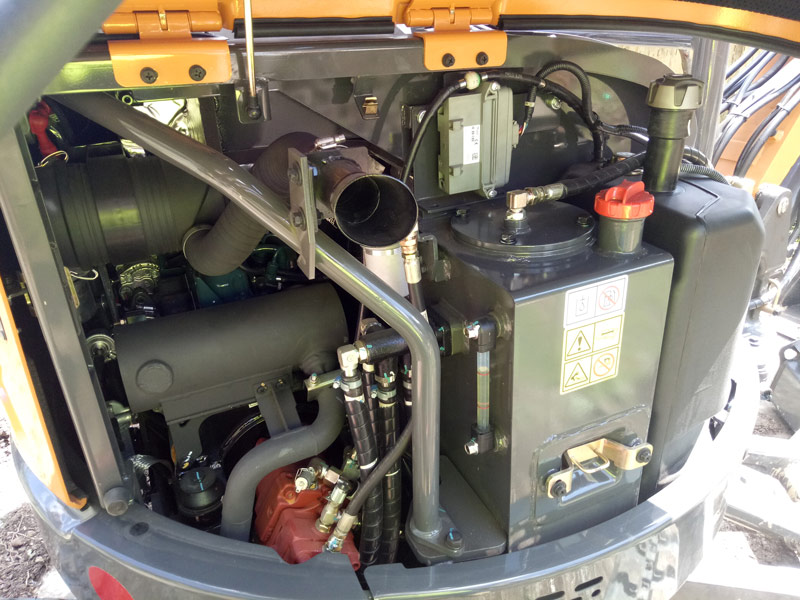 |
|
The engine put out 18.5kW/24.8hp@2400rpm
|
INSPECTION
As I started my walk around I noticed the track frame looks to be well constructed and a good length as I start to check the machine out from ground up. Double flange rollers aid in keeping the tracks firmly in position and the top of the track frame is angled slightly to help alleviate dirt build up.
The blade looks to be made of a sturdy box construction and sits quite a long way forward of the tracks with a good size shield sitting over the top of the ram.
I open the rear door to access the Tier 4, 3-cylinder, Kubota D1305 engine which looks to have a small amount of room to spare around it. Fluids and filters are easily accessible, although the engine oil dipstick is slightly awkward to access as you have to manoeuvre your hand in between a couple of hoses to reach it but filling points and battery isolator switch are in excellent position.
The side door gives access to fuel and hydraulic tanks with clear view to both sight glasses. Hydraulic pumps, filter and auxiliary line valves are also located in easy reach.
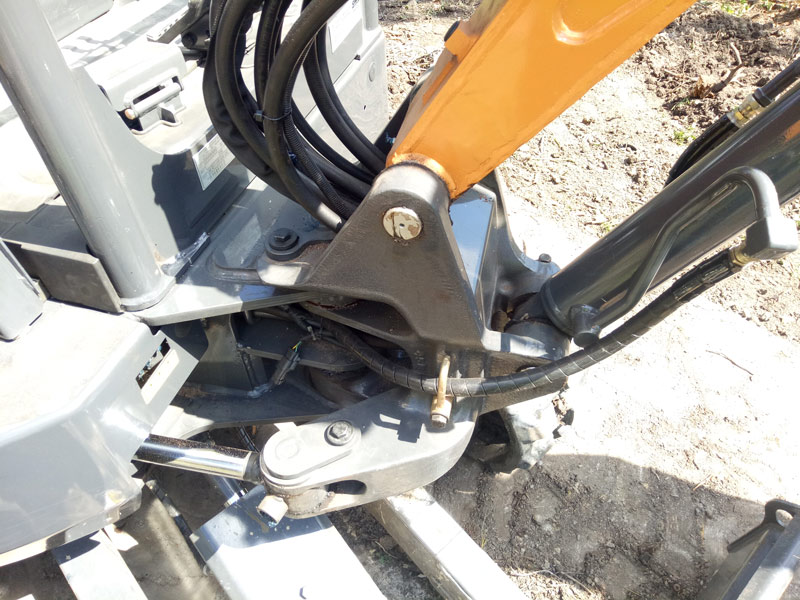 |
|
The boom pivot mount looks sturdy
|
BOOM
The boom looks to be well constructed with strong looking welds. Auxiliary lines are securely fastened along the top edges and onto dipper arm with the tilt hitch and bucket ram lines neatly tucked away over the back of the boom and down the back of the dipper.
Grease nipples are in easy reach with the machine, set up in the correct position, and the main lift ram has a shield to protect the spear. The boom pivot mount looks to be well constructed and sturdy.
 |
|
The features in the cabin are well-appointed
|
IN THE SEAT
Entry into the operator station is quite easy with good-size access afforded by the safety lever engaged, tucking the left control lever up out of the way. The seat is comfortable to sit in and the control levers feel good to hold with small pads also positioned under the operator forearms.
Although you will always be pushed for space in this class of excavator, legroom I feel was good for a machine this size. The travel levers have small foot pedals attached with a foot rest located to the left and auxiliary hydraulic foot pedal to the right that all look to be designed to take up the minimum amount of floor space yet afford a good amount of usability.
A small and simple digital dash is positioned on the right-hand side providing fuel level, coolant temp and warning lights such as engine oil pressure, battery charging, low fuel etc. The Engine Start Limitation (ESL) is also accessed through here, enabling the operator to set a five-digit pin code in order to stop unwanted usage by unauthorised operators.
The blade control lever is positioned next to the right-hand armrest with a couple of cup holders, one small, one large and a storage compartment big enough to fit your phone situated near the operators elbow area.
The left side is where you’ll find the rev control lever tucked away under the armrest along with the button to open and close the aftermarket Doherty tilt hitch. The canopy is ROPS, TOPS and FOPS rated, with good visibility afforded around the whole machine.
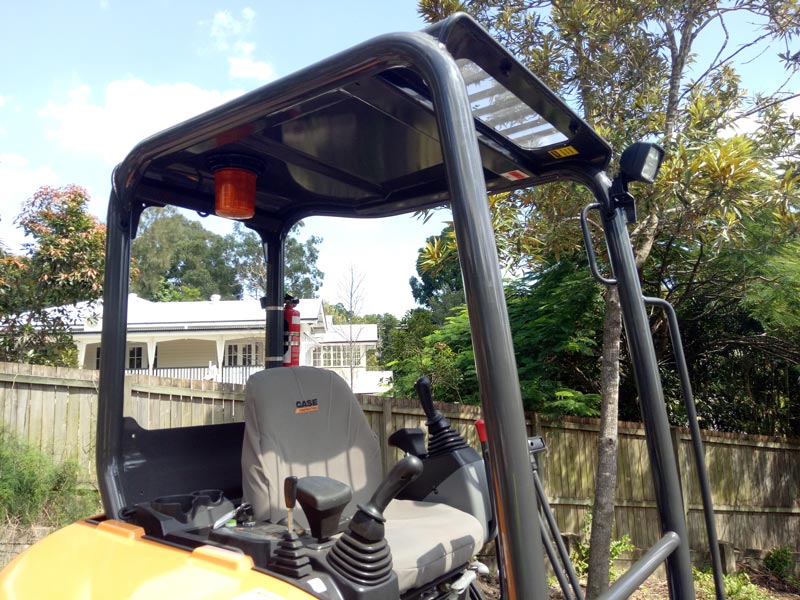 |
|
Solid roll protection and excellent visibility
|
TIME TO DIG
I cranked the machine into life and immediately set about swapping the wide cleaning bucket for the smaller GP bucket. It’s always good to be able to do this without the need of getting on and off the machine to fit safety pins thanks to the certified aftermarket tilt hitch.
My first job was to pull up an old concrete pad about 10 square metres in size with a small concrete block retaining wall situated on one side. It looked like it should be a fairly easy task as the concrete was only about 100mm thick and the wall was only three blocks high.
As I placed the bucket under the corner of the concrete, reality quickly set in as we realised that this little pad had been grossly over engineered with a good amount of steel mesh running through it and reinforcing up into the block wall – not to mention the large, round footings that also bore around 400mm deep into the ground … this was not going to be an easy task for a machine this size!
Let’s just say that I had the machine up on its tippy toes on more than a few occasions, but I think the added stability from the blade definitely aided with the extraction of the concrete as I was able to place it on top of the slab and pull it up in order to crack it. With the larger pieces, I would lift and drop a few times in order to break some of the thinner pieces off.
As I slowly dug my way back toward the wall, the concrete got harder as I hit the footings area so I replaced the GP bucket with the ripper and continued my attack on this atrocity. It took a little while and a few expletives but we were able to finally break everything up into small enough pieces for the skid steer loader to take away and load onto the truck. Once this was completed, I placed the cleaning bucket back on the machine to give the area a quick brush over and tidy up.
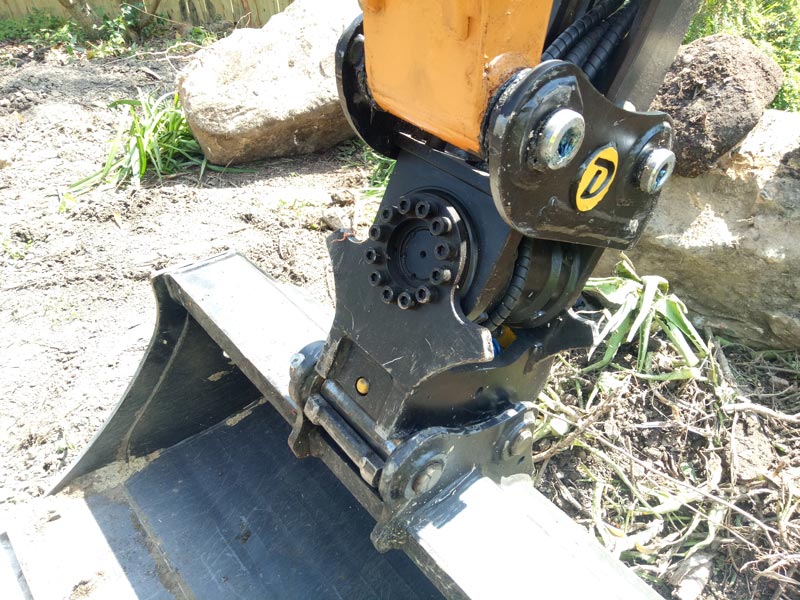 |
|
Strong linkages all the way through
|
BOTTOM LINE
According to their website, “CASE Construction Equipment is built on the principle that simple is better.” Nothing could probably be closer to the truth with my experience on this particular machine. There are no real bells and whistles, these guys seem to rely on good old fashion guts and reliability through tried and tested parts and components.
I was impressed with the strength and breakout force when it came to excavating the concrete pad. Even though it was a bit of a struggle at times, the only thing lacking was the weight of the machine itself as it could easily break out and lift the concrete in front of the blade but would find it too heavy to swing around and sidecast without putting the machine up on one track, hence having to keep the bucket in close to the machine and almost on the ground. Note that this was only because the concrete was oversize for the machine; I have operated larger machines in the past that would have struggled with breaking up and moving this particular concrete pad.
The operating levers were still a little stiff as you would expect from a machine with only 12 hours on the clock but overall it was very responsive, fast and, when it came to final trimming, it was easy to achieve a nice clean cut without much effort.
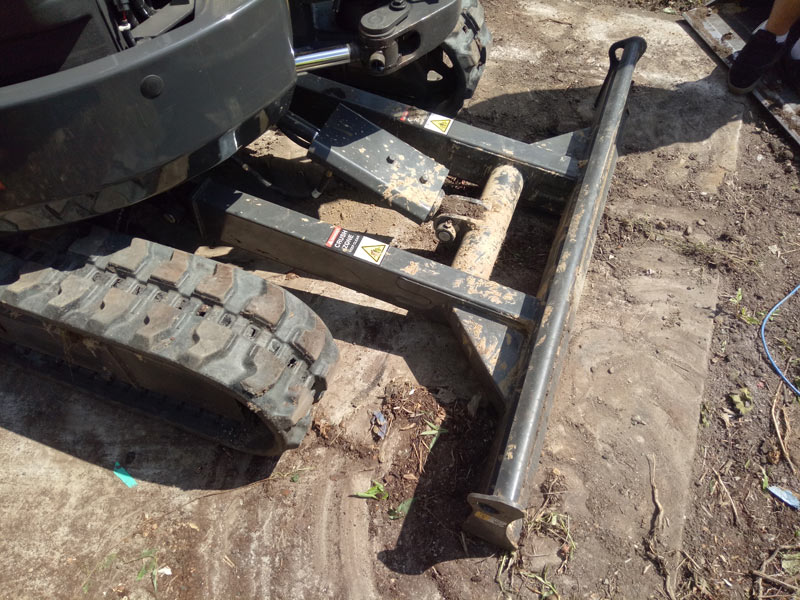 |
|
The blade sits quite a long way forward of the tracks
|
The tramming levers with their small foot pedals attached were handy for using with your feet going forward but left me feeling somewhat cramped in reverse, which is usually expected on a machine this size. Travel speed is very good and the high/low speed switch is conveniently positioned on the tramming lever.
The operator seat and work station are set out pretty well and comfortable but the only real fault I could find with this machine was the amount of hot air protruding up on the right-hand side of the operator between the body of the machine and the seat while the machine is working. I presume that this would only be an issue for the open-air canopy type of machine but it maybe something that Case could have a look at in the future, especially when it comes to the Queensland market.
I have always been a fan of simple machines. There is nothing that I enjoy more than watching a good operator creating a work of earthmoving art simply through an extension of their eyes, hands and feet. At the end of the day, you can have all the tricks available on your machine but only one real question remains: can it dig? The answer in this case is … yes! It can dig very well actually, and that is the main thing that you need to have in today’s very congested mini excavator market.
I was impressed with my very first outing at the controls of a Case machine and would be happy to try another anytime, but everyone has differing opinions, so don’t go taking my word for it … try one out for yourself and make up your own mind!
KEEP READING
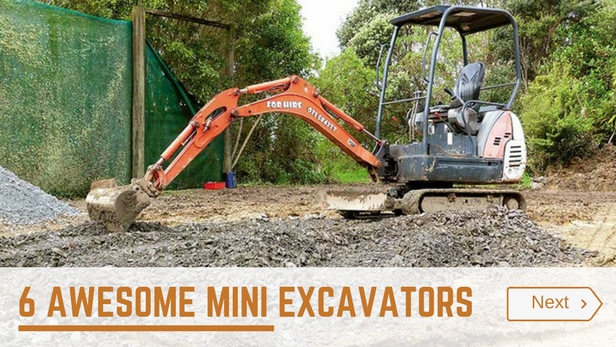 |
|

